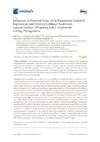Identificador persistente para citar o vincular este elemento:
https://accedacris.ulpgc.es/jspui/handle/10553/76114
| Título: | Influence of parental fatty acid desaturase 2 (Fads2) expression and diet on gilthead seabream (sparus aurata) offspring fads2 expression during ontogenesis | Autores/as: | Xu, Hanlin Shajahan, Ferosekhan Turkmen, Serhat Afonso, Juan Manuel Zamorano, Maria Jesús Izquierdo, Marisol |
Clasificación UNESCO: | 310502 Piscicultura | Palabras clave: | Aquaculture Embryogenesis Lipid Metabolism Parental Gene Expression Parental Nutritional Status |
Fecha de publicación: | 2020 | Proyectos: | Consumer driven Production: Integrating Innovative Approaches for Competitive and Sustainable Performance across the Mediterranean Aquaculture Value Chain | Publicación seriada: | Animals | Resumen: | Previous studies have shown that it is possible to increase the ability of marine fish to produce long-chain polyunsaturated fatty acid from their 18C precursors by nutritional programming or using broodstock with a higher fatty acyl desaturase 2 (fads2) expression. However, those studies failed to show the effect of these interventions on the expression of the fads2 gene in the developing egg. Moreover, there were no studies on the temporal expression of the fads2 during ontogeny in the gilthead sea bream (Sparus aurata). In order to determine the changes in expression of fads2 during ontogeny, gilthead sea bream broodstock with a high (HRO) or low (LRO) fads2 expression fed a diet previously used for nutritional programming, or a fish oil-based diet (LFO) were allowed to spawn. The samples were taken at the stages of spawning, morula, high blastula, gastrula, neurula, heart beating, hatch and 3 day-old first exogenous feeding larvae to determine fads2 expression throughout embryonic development. The results showed the presence of fads2 mRNA in the just spawned egg, denoting the maternal mRNA transfer to the developing oocyte. Later, fads2 expression increased after the neurula, from heart beating until 3-day-old larvae, denoting the transition from maternal to embryonic gene expression. In addition, the eggs obtained from broodstock with high fads2 expression showed a high docosahexaenoic acid content, which correlated with the downregulation of the fads2 expression found in the developing embryo and larvae. Finally, feeding with the nutritional programming diet with the partial replacement of fish oil by rapeseed oil did not affect the long chain polyunsaturated fatty acid (LC-PUFA) contents nor fads2 expression in the gilthead sea bream developing eggs. | URI: | https://accedacris.ulpgc.es/handle/10553/76114 | ISSN: | 2076-2615 | DOI: | 10.3390/ani10112191 | Fuente: | Animals [ISSN 2076-2615], v. 10 (11), 2191, (Noviembre 2020) |
| Colección: | Artículos |
Citas SCOPUSTM
6
actualizado el 08-jun-2025
Citas de WEB OF SCIENCETM
Citations
6
actualizado el 08-jun-2025
Visitas
255
actualizado el 12-jul-2025
Descargas
177
actualizado el 12-jul-2025
Google ScholarTM
Verifica
Altmetric
Comparte
Exporta metadatos
Los elementos en ULPGC accedaCRIS están protegidos por derechos de autor con todos los derechos reservados, a menos que se indique lo contrario.
